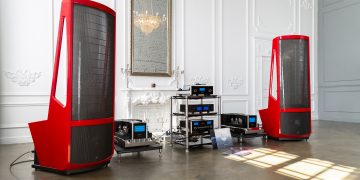"Spherical High End in a vacuum" - this is the definition that can reflect the scale of the phenomenon, which will be discussed later. Neolith acoustics from Martin Logan are collected by all the canons of High End - it is high-tech, madly beautiful and monstrously expensive. And in its quest for perfection, the developers have gone so far that it has become a problem not only for competitors, but also for future owners, who will have to make many sacrifices on the altar of audiophile. However, everything by order.
Let us start with the fact that electrostatic technology itself has many technological advantages over traditional dynamic emitters. An almost weightless diaphragm thinner than a human hair obediently follows the slightest signal change and produces sound much more accurate and pure than any other high-tech cone of a conventional driver. Weak spots in the electrostats also exist, what can we hide? The physical properties of the diaphragm and the sandwich design of the driver, in which it is literally clamped between two metal grilles, severely limit the working stroke. This can be compensated for in part by increasing the area of the transmitter, because the larger the area, the smaller the amplitude required to achieve the desired sound pressure. However, there are limits to everything and to get a really deep bass electrostat would have to be made just giant. That's why the developers of Martin Logan turned to a reasonable engineering solution. They gave the whole bass range to traditional dynamic drivers, which in a narrow range are able to work very effectively. Such hybrids with active or passive subwoofer section are the main backbone of the company's range. And here it makes sense to remember that the most modest electrostatic speaker by Martin Logan standards is at least the top Hi-Fi, and rather - High End from the point of view of the industry as a whole.
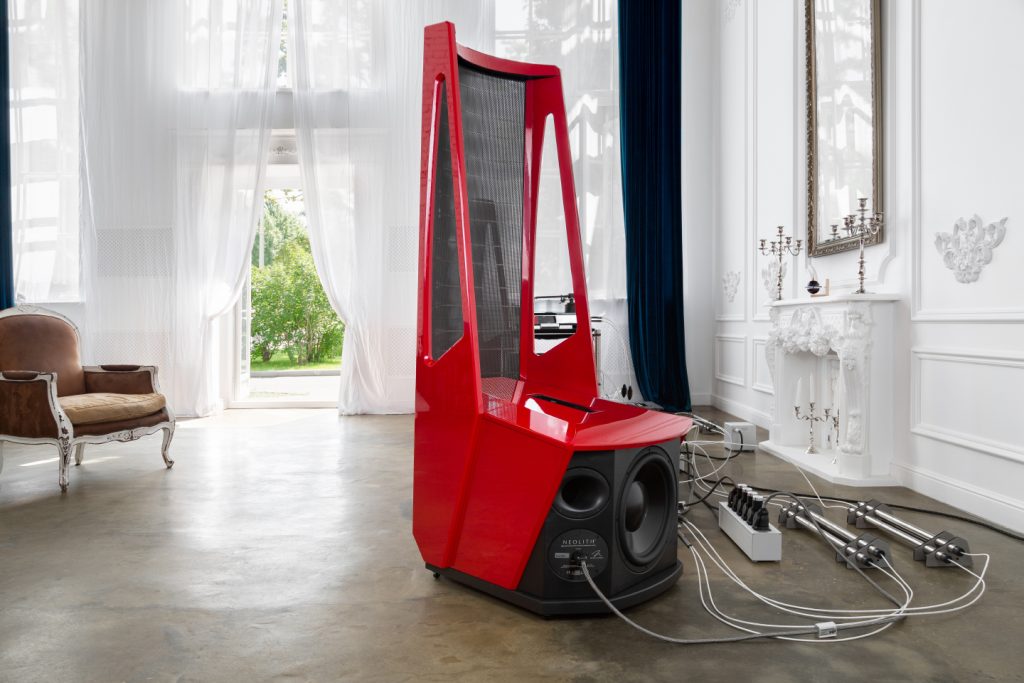
On the background of such a powerful technological advantage, the Neolith model was created. But to ascend to the throne, just scaling the structure to XXXL size is not enough, so the developers have made many changes and additions wherever possible and justified.
The first thing that catches your eye is an absolutely fantastic appearance. The acoustic enclosure is painted in bright red by the technology used for luxury cars. The similarity with elite sports cars is enhanced by leather inserts, as well as the combination of chopped forms in the Lamborghini style with smooth lines reminiscent of classic Porsche contours. Together, this creates a completely unique and unique image, literally imbued with the spirit of luxury.
Aerodynamic forms in the design of acoustics usually appear for a reason, and not only for design reasons, from which we can assume that Neolith in this respect is not an exception. The absence of sharp angles in the RF/HF region and streamlined forms of the bass section provide a significant positive contribution to sound by eliminating the main causes of diffraction distortion. The curved shape of the electrostatic transducer, combined with the dipole principle of operation, provides an optimal directional sound wave, creating minimal reflections from the floor, ceiling and side walls.

As a construction material of the cabinet was chosen polymer composite, which has a high mechanical strength and prevents the spread of vibrations. The ability to create such bizarre forms without losing the rigidity of the structure is also his merit.
The key element of the Neolith model is a large electrostatic radiator, the largest in the Martin Logan range. And it looks like it's basically the largest of its production to date - its effective area is nearly 0.7 meters.2. Such an impressive area allows you to get a solid sound pressure, as well as increases the dynamic range, in other words, this electrostatic panel is superior in terms of sound dynamism of any other electrostats with a smaller size. If we were talking about a dynamic transmitter, the increase in size would lead to a loss of microdynamics and degrade the upper frequencies, but the electrostatic transmitter is not inclined to such manifestations, so the obvious advantages are not accompanied by disadvantages.
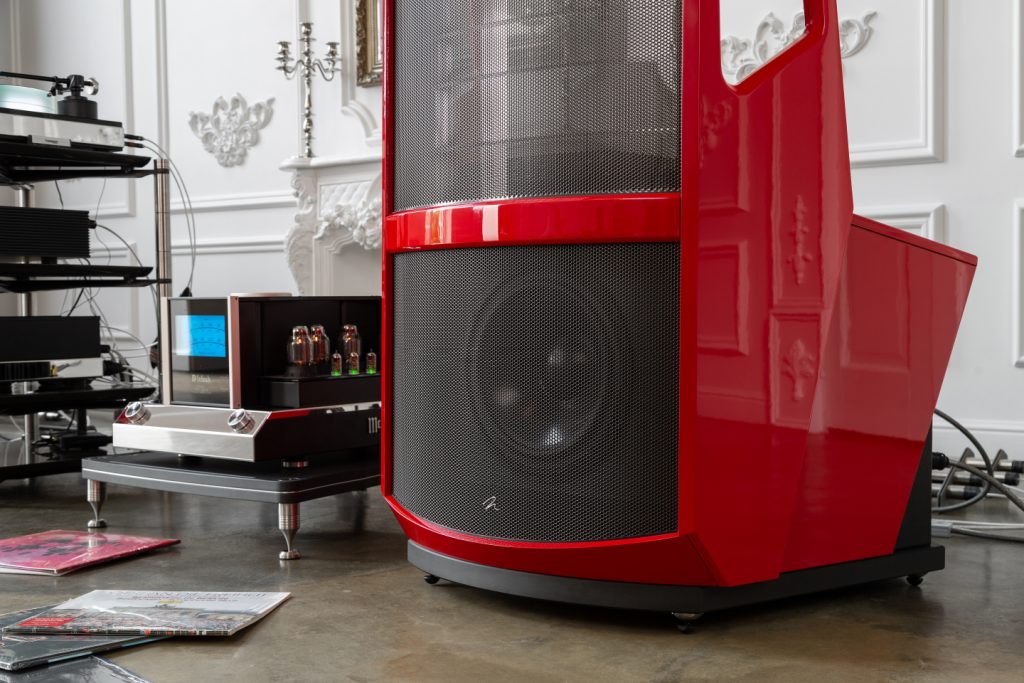
There are two traditional drivers in the design and Martin Logan's developers had to try to bring all the key quality features of the bass section to a level that sets the electrostatic bass/midrange module. The rear panel has a 15-inch driver with a rigid aluminum cone and a four-layer voice coil. This driver is responsible for frequencies below 60 Hz. The front bass driver, whose operating range is directly coupled to the electrostatic driver, is located on the front panel and equipped with a multilayer cone with a carbon fiber coating. Both speakers have a longer stroke, open baskets and a vented magnetic system to minimize compression and distortion at high volume.

Traditionally, at the base of all older models of Martin Logan electrostats is installed an active subwoofer section with DSP, which allows you to adapt the sound to the acoustics of the room. In Neolith, another way was chosen: both subwoofers are passive, which, according to the manufacturer, allows the user to choose amplifiers with the appropriate sound character. The message is generally noble and quite consistent with the ideas of High End. However, in today's realities this can create additional problems, because the power range of this model is specified in the range 20-1300 W. This means that it would be good to provide each channel with 1 kW of power for efficient operation, but the available range of suitable amplifiers will be very, very limited. The only thing that calms you is that those few candidates will be worthy, because nothing but High-End models will provide such power.
In addition to the problem of choosing the right amplifier, the passive principle of operation gave rise to another problem: the inability to use the DSP to adapt the sound of the speakers to the listening environment. And it's simply impossible to do without calibrating the sound of a system with such large speakers, because the size of the rooms they have to sound varies enormously.
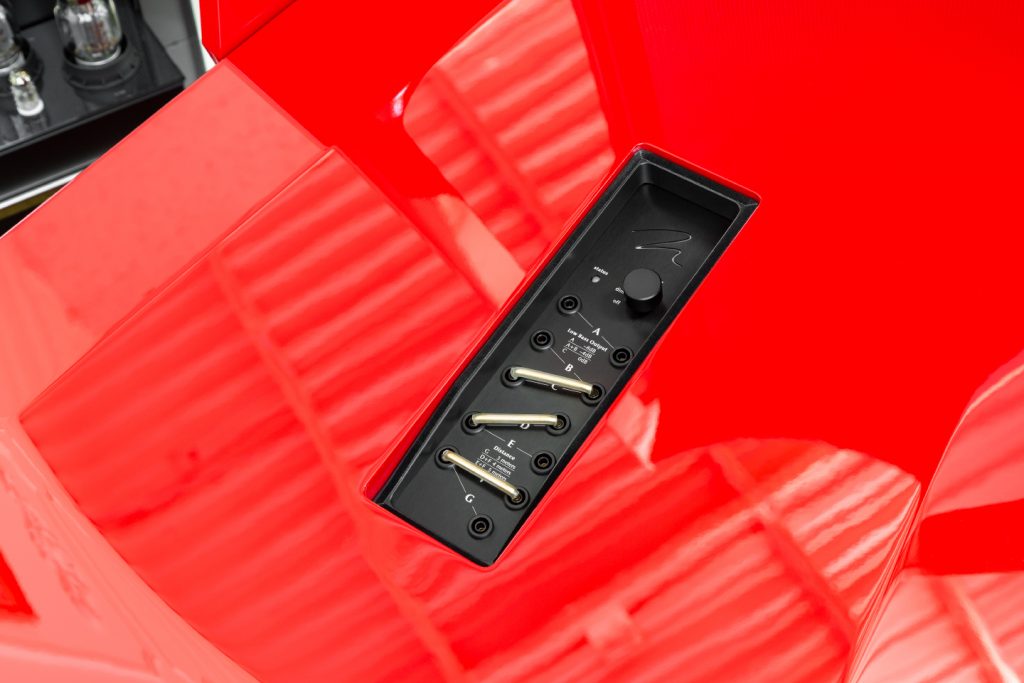
The solution to the problem was a configurable crossover. Two adjustments, made by rearranging the powerful jumpers, perform different functions and the combination of which helps to adapt the sound to the existing conditions. The first adjustment controls the large bass response, allowing you to set levels 0, -4 and -8 dB, thus changing the amount of bass. The second adjustment is more interesting: it allows you to shift the focus point. This is due to the change in the crossover frequency between the second bass and electrostatic transmitter within 250 ... 400 Hz, and most likely there are some manipulations with phase response. The minimum adjustment is for listening from a distance of less than 3 m, the middle position is marked as 4 m and the maximum distance starts from 5 m. Since the electrostatic transducer is dipole and has a horizontal orientation of only 30°, the distance from the walls and the turn of the acoustics will also play a significant role in the formation of the sound stage. In sum, this gives a wide field for experimentation, but also requires a lot of free space.
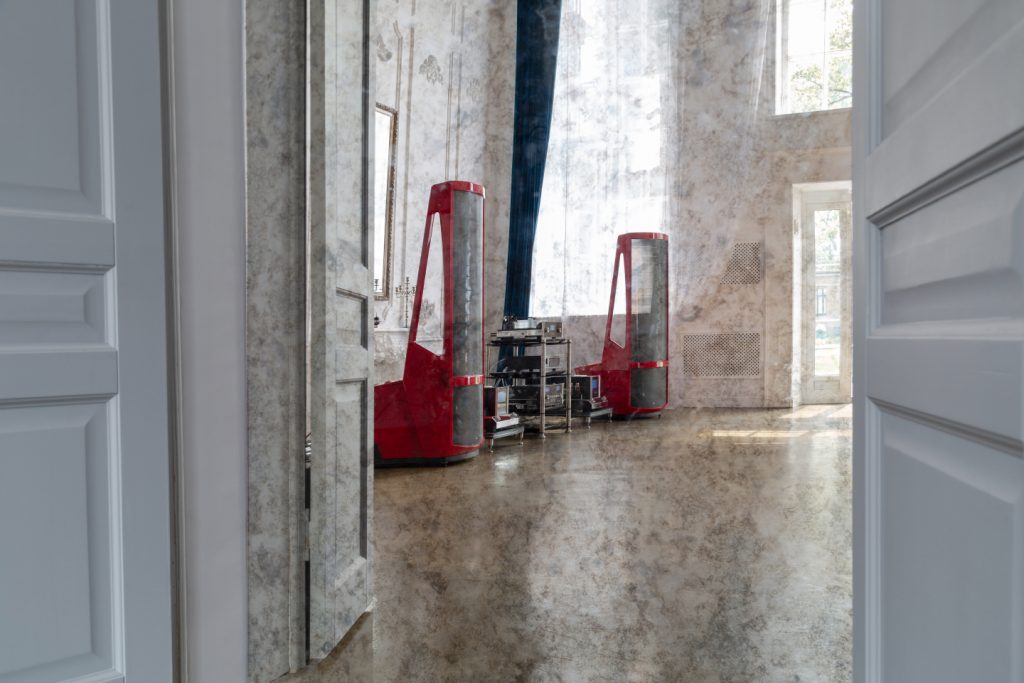
Listening to the speakers of this class is an event that occurs infrequently. Simply because it is not an easy task to assemble such a number of unique components in one suitable room. The system, presented to the Russian public, was demonstrated in a spacious hall, quite suitable in scale for Neolith. The most interesting components of the system, in addition to the acoustics itself, were power amplifiers. Double monoblock MC901 from McIntosh were designed, it seems, just for such cases. A total of one such amplifier produces 900 W of power, of which 600 W provides a transistor amplifier connected to the bass section of the speakers, and 300 W provides a lamp circuit, responsible for the upper and mid frequencies. The dual amplifier principle of the monoblocks unambiguously indicates a double pointer indicator that displays the level separately for the lamp and transistor sections. And though according to the passport the acoustics has sensitivity of 90 dB, already at the average volume the arrows did not leave the middle zone of the scale and often went further to the right.

The rest of the track consisted of a preamplifier and a McIntosh vinyl player, which company was a digital source Aurender A30. All this looked no less spectacular, but already more familiar. And really epic part of the setapa, comparable in scale of engineering thought with huge electrostats, was located behind the system. High fidelity cables, equipped with unique magnetic "gas pedals" and massive modular network filters. Mudra Akustik made an indelible impression by its appearance, causing associations with a powerful power substation. In addition, they surprised by the non-standard approach to solving the usual technological problems.
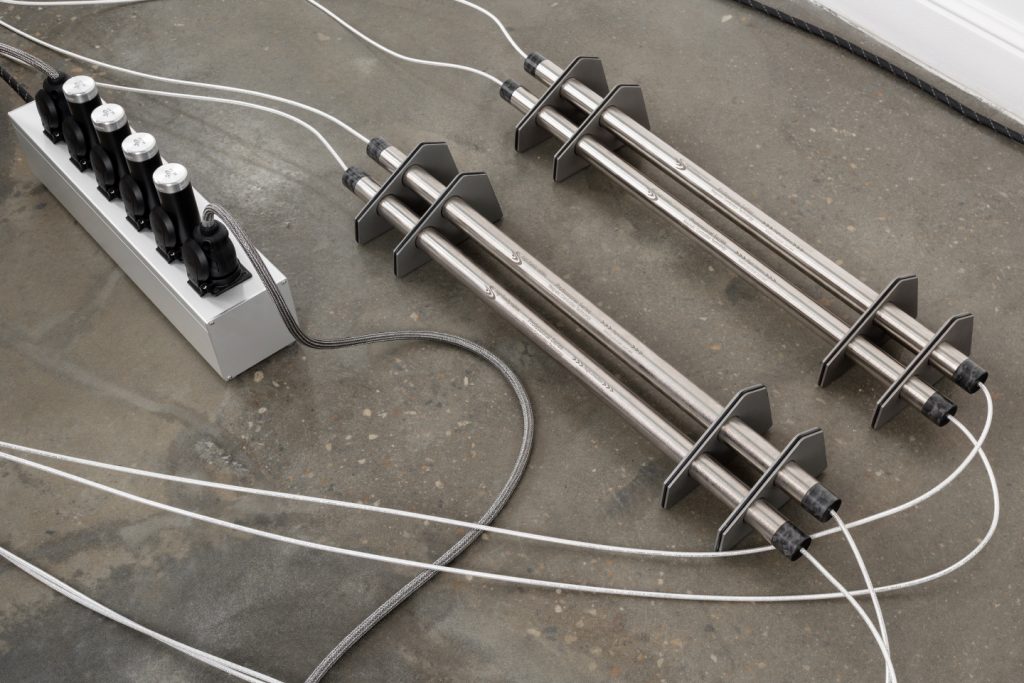
But still, the most important thing is that such an extraordinary set of components has formed into something absolutely fantastic.
The first thing that the system beats the listener is literally a huge sound stage: perfectly drawn and surrounding the listener from all sides. When listening to it, sometimes there is a desire to get up from the chair and take a walk inside the resulting sound space, bypass all the musicians, and "see" the picture from different sides.
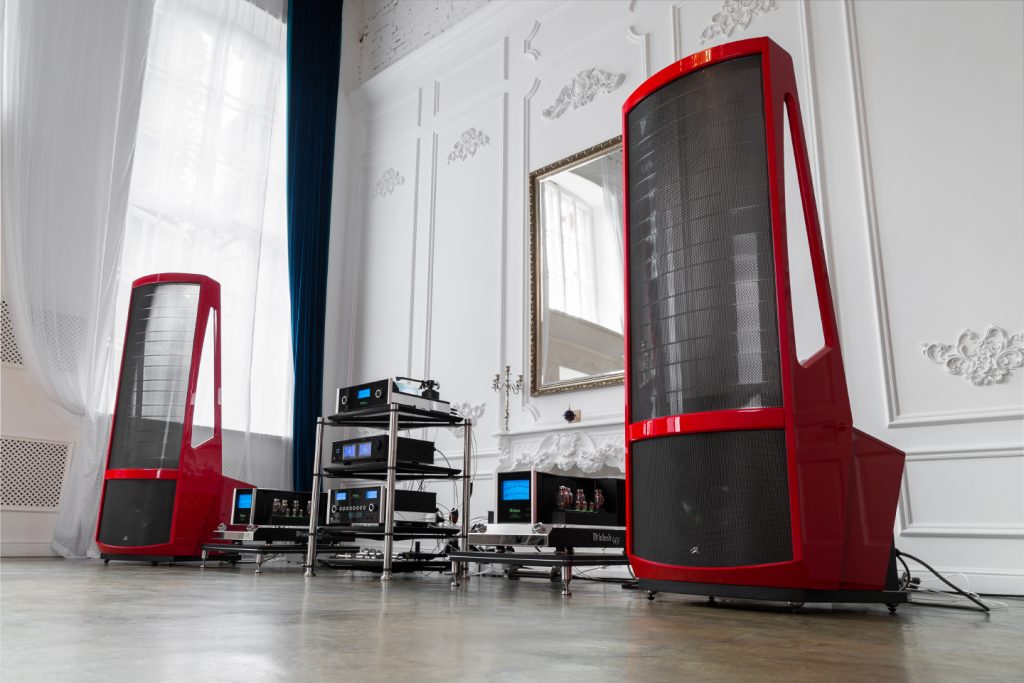
The impression of absolute realism of what is happening is supported by a solid dynamic range, which sometimes seems simply limitless. Neolith's bass supply is just a reference. In a large room, which does not have any serious acoustic training, accuracy and focus were maintained on the lowest notes. Parts of live double bass in jazz and synthetic basslines in electronic tracks sounded very powerful, thoroughly, with a clear drawing of each note, without failures or dominance of any individual sounds. For a system that does not have any sound adjustment other than a pair of jumpers in the crossover, the result is simply excellent.
In general, the acoustics was very neutral in sound and transparent to the rest of the path. The nature of the sound of Neolith itself is quite problematic to hear, but you can unmistakably distinguish the sound of vinyl from the number or CD from the first sounds of Hi-Res. The lamp nature of the amplifier's midrange/high frequency section was quite obvious as well, which surprisingly did not dissonate or contrast with the clear transistor sound of the bass section.

As for the quality and nature of the mastering, Neolith's exceptional resolution was very curious. Modern mixes sounded extremely transparent, surrounded, with many details distributed in space. The wildest fantasies of sound engineers and sound producers were embodied flawlessly. It is enough to turn on something atmospheric from Aphex Twin or, for example, David Bowie's "Blackstar", and immediately a teleport into another universe.
But the question immediately arises out of this context: what will happen if you listen to something recorded with obviously poor quality? It is not difficult to make such an experiment. When listening to the early Led Zeppelin and the most popular Lo-Fi release of all time - Deep Purple "In Rock" the same thing happened as with modern mixes, only the feeling of space was replaced by the atmosphere of a cramped and old analogue studio, located right in front of the listener. Even the monophonic recordings of The Beatles and Ella Fitzgerald performed by Neolith sounded very natural and lively, literally dragging the listeners into active emotional listening from the first notes.
Reproduction of academic music is a treat. Here again, every recording is good in its own way, but the most impressive are the modern releases, in which Neolith demonstrates a perfect separation of instruments, allowing you to hear each violin separately without any loss of musicality and integrity of the composition. With these qualities, the most complex avant-garde compositions and improvisational music became surprisingly clear and easy to grasp.

Completing the story about sound and acoustics in general, it should be noted that Martin Logan Neolith has no real competitors. With their impeccable resolution and perfectly calibrated tonal balance inherent to electrostatic technology, they are as good as the best traditional speakers in terms of dynamics, density and vigor. This provides an advantage that is engineeringly obvious and undeniable when listening. And the fact that these are the first contenders for the title of the most stylish and luxurious loudspeaker in history is an additional bonus.
However, everything can't be perfect, and with all these advantages Neolith has its obvious disadvantages or, to be more precise, limitations. The minimum room size for this model corresponds to the volume in which most of the speakers are no longer able to work. Approximately in the same way we can formulate the problem of amplifier selection: most of the amplifiers simply can't cope with the task. And a third problem, the least obvious at first glance, but very tangible in practice: the highest quality requirements for all components of the system in which Neolith will work. Only components and cables of the highest quality class can unlock the full potential of this model.

It would be at least imprudent of me to recommend Neolith to buy, addressing the large audience, but to listen to these speakers, if such a possibility happens - it is the direct responsibility of every audiophilist!
Review author: Maxim Naumov
